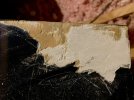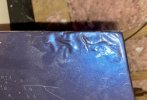The hood and headlight cover on one of my corvettes (a 2000) fell pray to the trailer hitch on a lifted truck and I'd like to try and repair it. I'm a backyard hack at best, but I've painted a number of vehicles and boats. I've also played around with blending base coat repairs (starting with intercoat clear so the new base pigment will lay down like the old) and burning clear repairs in without leaving a halo using blending solvent, etc... to the point where I have a difficult time finding the repairs I did.
What I'm worried about in this situation is the dreaded bubble under the repair when the metallic navy blue pearl sits in the hot North Carolina. The damage has been exposed to the weather for a while now, so I'm not even sure if I'm able to get it dry enough knowing how water can wick it's way along glass fibers in a composite. Is it going to be good enough to grind out the damage, feather out the edges and then seal it with epoxy (no exposure to anything that's not 100% solids?), is there something else I need to do? or am I on a "fool's errand" even trying?
I did some searches and didn't find this specific issue addressed. As always I greatly appreciate the experience folks on here share.
ps. I painted the hood that's on this car using ppg dbc basecoat over spi epoxy primer and shot several heavy handed coats of spi euro clear over the base. I intend to us the same base and clear for the repair and will scuff and clear all of the panels repaired (maybe even the whole front of the car...
What I'm worried about in this situation is the dreaded bubble under the repair when the metallic navy blue pearl sits in the hot North Carolina. The damage has been exposed to the weather for a while now, so I'm not even sure if I'm able to get it dry enough knowing how water can wick it's way along glass fibers in a composite. Is it going to be good enough to grind out the damage, feather out the edges and then seal it with epoxy (no exposure to anything that's not 100% solids?), is there something else I need to do? or am I on a "fool's errand" even trying?
I did some searches and didn't find this specific issue addressed. As always I greatly appreciate the experience folks on here share.
ps. I painted the hood that's on this car using ppg dbc basecoat over spi epoxy primer and shot several heavy handed coats of spi euro clear over the base. I intend to us the same base and clear for the repair and will scuff and clear all of the panels repaired (maybe even the whole front of the car...


